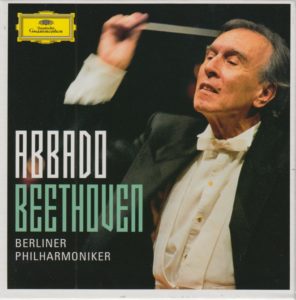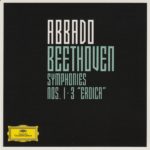 This morning, I begin another of my insane year-long musical explorations.
This morning, I begin another of my insane year-long musical explorations.
Unlike previous projects (see My Year-Long Project page), I know this one will be interrupted by at least two life events: knee-replacement surgery, and a trip to Australia.
I have no idea how I’ll continue with this Beethoven project with those two things looming before me.
But I can’t live my life wondering what will happen in the future.
So I’m starting today, knees and wallabies notwithstanding.
The first conductor to which I’ll listen is Claudio Abbado (1933-2014), who is new to me. I’ve heard a lot of conductors over the last 10 years. But I don’t recall ever hearing something the late Maestro Abbado (1933-2014) conducted.
 I have, however, heard the Berliner Philharmoniker, his orchestra for this particular symphony.
I have, however, heard the Berliner Philharmoniker, his orchestra for this particular symphony.
According to its entry on Wikipedia,
Ludwig van Beethoven’s Symphony No. 1 in C major, Op. 21, was dedicated to Baron Gottfried van Swieten, an early patron of the composer. The piece was published in 1801 by Hoffmeister & Kühnel of Leipzig. It is not known exactly when Beethoven finished writing this work, but sketches of the finale were found to be from 1795.
The symphony is clearly indebted to Beethoven’s predecessors, particularly his teacher Joseph Haydn as well as Wolfgang Amadeus Mozart, but nonetheless has characteristics that mark it uniquely as Beethoven’s work, notably the frequent use of sforzandi and the prominent, more independent use of wind instruments. Sketches for the finale are found among the exercises Beethoven wrote while studying counterpoint under Johann Georg Albrechtsberger in the spring of 1797.
The premiere took place on 2 April 1800 at the K.K. Hoftheater nächst der Burg in Vienna.
So, this particular piece was composed somewhere between the dates 1795–1801. Beethoven was born in 1770. He died in 1827. Therefore, he was 25 when he started his first symphony and approximately 31 when he finished.
This – at well under 30 minutes – is a relatively short symphony, it seems to me. But, at least in this case, size does not matter. Although not as complex as Beethoven’s later compositions, his Symphony No. 1 is stirring and fun.
Beethoven wrote his symphonies in four parts (except for the Sixth, which is in five). The time breakdown of this one (Symphony No. 1 in C Major), from this particular conductor (Abbado, at age 68) and this particular orchestra (Berliner Philharmoniker), at this particular time in history (February, 2001) on this particular record label (Deutsche Grammophon) is as follows:
I. Adagio molto………………………………………………………………………………..9:04
II. Andante cantabile con moto………………………………………………………7:39
III. Menuetto. Allegro molto e vivace……………………………………………….4:34
IV. Adagio – Allegro molto e vivace…………………………………………………5:34
Total running time: 26:20
My Rating:
Recording quality: 4 (typical Deutsche Grammophon fare – crisp, clean, and exciting, with just a bit of tape hiss or other ambient sounds)
Overall musicianship: 5
CD liner notes: 3 (a decent essay – written in English, German, French, and Italian) about Maestro Abbado’s “universality” of Beethoven’s recordings)
How does this make me feel: 4
This morning, my favorite of the four movements is IV – Adagio. My head was bobbing and I was smiling at this triumphant ending to the first symphony Beethoven composed.
Of Abbado’s interpretation of Beethoven’s works, the liner notes (written by Enrico Girardi) tell us this:
It is true that this is another kind of Beethoven we are talking about: a less powerful one, less bound up with those marvelously mellow sounds that even Karajan’s detractors gave him credit for. Instead, the music is more transparent and radiant, more clearly articulated, more varied in rhythmic and dynamic contrasts, more electric and tense.
Perhaps.
I’ll be able to tell more how Abbado’s interpretations differ from everyone else’s as my project proceeds.
I will say this: The DG recording and the performance from the Berliner Philharminiker are airy and bright. This isn’t a heavy Beethoven, crushed under its ponderous importance. This sounds lively and, well, fun to me.
Incidentally, the Wiki bio used a word with which I was not familiar: sforzandi. I clicked on the hyperlink on the Wiki site and it took me to the page called Dynamics, and I can vouch for that. Beethoven’s music certainly is dynamic.
The Wiki entry for Dynamics tells us this:
In music, the dynamics of a piece is the variation in loudness between notes or phrases. Dynamics are indicated by specific musical notation, often in some detail. However, dynamics markings still require interpretation by the performer depending on the musical context: for instance a piano (quiet) marking in one part of a piece might have quite different objective loudness in another piece, or even a different section of the same piece. The execution of dynamics also extends beyond loudness to include changes in timbre and sometimes tempo rubato.
I guess I’d never considered that dynamics requires interpretation. I thought it was clearly marked how loud and soft a piece of music should be.
Huh. Live and learn.
